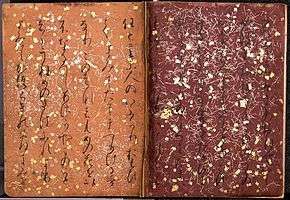Kokin Wakashū

The Kokin Wakashū (古今和歌集, "Collection of Japanese Poems of Ancient and Modern Times"), commonly abbreviated as Kokinshū (古今集), is an early anthology of the waka form of Japanese poetry, dating from the Heian period. It is an Imperial anthology, conceived of by Emperor Uda (r. 887–897) and published by order of his son Emperor Daigo (r. 897–930), in about 905. Its finished form dates to c. 920, though according to several historical accounts the last poem was added to the collection in 914. The compilers of the anthology were four court poets, led by Ki no Tsurayuki and also including Ki no Tomonori (who died before its completion), Ōshikōchi no Mitsune, and Mibu no Tadamine.
Significance
The Kokinshū is the first of the Nijūichidaishū (二十一代集), the 21 collections of Japanese poetry compiled at Imperial request. It was the most influential realization of the ideas of poetry at the time, dictating the form and format of Japanese poetry until the late nineteenth century; it was the first anthology to divide itself into seasonal and love poems. The primacy of poems about the seasons pioneered by the Kokinshū continues even today in the haiku tradition.
The Japanese preface by Ki no Tsurayuki is also the beginning of Japanese criticism as distinct from the far more prevalent Chinese poetics in the literary circles of its day. (The anthology also included a Classical Chinese preface authored by Ki no Yoshimochi.) The idea of including old as well as new poems was another important innovation, one which was widely adopted in later works, both in prose and verse. The poems of the Kokinshū were ordered temporally; the love poems, for instance, though written by many different poets across large spans of time, are ordered in such a way that the reader may understand them to depict the progression and fluctuations of a courtly love-affair. This association of one poem to the next marks this anthology as the ancestor of the renga and haikai traditions.
Structure
The exact number of poems in the collection varies depending on the textual tradition. The online edition,[1] which follows the Date Family text based on a manuscript prepared by Fujiwara no Teika, contains 1,111 poems. The collection is divided into twenty parts, reflecting older models such as the Man'yōshū and various Chinese anthologies. The organization of topics is however different from all earlier models, and was followed by all later official collections, although some collections like the Kin'yō Wakashū and Shika Wakashū scaled the model down to ten parts.
The following divisions of the Kokinshū mention the Japanese names of the parts,[1] their modern readings,[2][3] and their English translations.[4]
| topic | parts | |||
|---|---|---|---|---|
| Seasons | 1-2 | Spring | 春歌 | haru no uta |
| 3 | Summer | 夏歌 | natsu no uta | |
| 4-5 | Autumn | 秋歌 | aki no uta | |
| 6 | Winter | 冬歌 | fuyu no uta | |
| 7 | Congratulations | 賀歌 | ga no uta | |
| 8 | Partings | 離別歌 | wakare no uta | |
| 9 | Travel | 羈旅歌 | tabi no uta | |
| 10 | Acrostics | 物名 | mono no na | |
| Love | 11-15 | Love | 恋歌 | koi no uta |
| Miscellany | 16 | Laments | 哀傷歌 | aishō no uta |
| 17-18 | Miscellaneous | 雑歌 | kusagusa no uta | |
| 19 | Miscellaneous Forms | 雑躰歌 | zattai no uta | |
| 20 | Traditional Poems from the Bureau of Song |
大歌所御歌 | ōutadokoro no on'uta | |
The compilers included the name of the author of each poem, and the topic (題 dai) or inspiration of the poem, if known. Major poets of the Kokinshū include Ariwara no Narihira, Ono no Komachi, Henjō and Fujiwara no Okikaze, apart from the compilers themselves. Inclusion in any imperial collection, and particularly the Kokinshū, was a great honour.
Manuscripts
On October 20, 2010, Kōnan Women's University announced the discovery of a complete manuscript dating to c. 1220–1240. It is the oldest manuscript to contain both the kanji and kana prefaces. It is split into two volumes, 15.9 cm tall by 14.6 cm wide, totaling 429 pages containing all 1111 poems. It is thought to be a copy of a manuscript made by Fujiwara no Teika, but the identity of the copier is unknown. The manuscript was purchased from a used book store in 1982 for 4,280,000 yen.[5][6][7]
See also
- List of National Treasures of Japan (writings: Japanese books)
- Shin Kokin Wakashū
- Heian literature
- Minamoto no Tōru
Notes
- 1 2 Online edition of the Kokin wakashu at the UVa Library Japanese Text Initiative.
- ↑ Miner (1985), pages 186–187
- ↑ McCullough
- ↑ Brower, pg 482
- ↑ "古今和歌集:鎌倉初期の写本と判明 甲南女子大所蔵". Mainichi Shimbun. October 20, 2010. Retrieved October 22, 2010.
- ↑ "古今和歌集の写本、鎌倉初期の「完本」と確認". Yomiuri Shimbun. October 20, 2010. Retrieved October 22, 2010.
- ↑ "古今和歌集、完全写本見つかる=漢字、仮名序文付きで最古-甲南女子大". Yahoo! News. October 20, 2010. Retrieved October 22, 2010.
References
- Saeki, Umetomo (1958). Nihon Koten Bungaku Taikei: Kokin Wakashū. Iwanami Shoten. ISBN 4-00-060008-7.
- Kojima, Noriyuki; Eizō Arai (1989). Shin Nihon Koten Bungaku Taikei: Kokin Wakashū. Iwanami Shoten. ISBN 4-00-240005-0.
- Miner, Earl; H. Odagiri; R. E. Morrell (1985). The Princeton Companion to Classical Japanese Literature. Princeton University Press. pp. 186–187. ISBN 0-691-06599-3.
- McCullough, Helen Craig (1985). Kokin Wakashū: The First Imperial Anthology of Japanese Poetry. Stanford University Press. ISBN 0-8047-1258-1.
- Brower, Robert H.; Earl Roy Miner (1961). Japanese court poetry. Stanford University Press. LCCN 61-10925.
External links
- Manuscript scans at Waseda University Library: 1 volume (unknown year), 2 volumes (unknown year), 1 volume (unknown year), 1553 (Sanjōnishi Kin'eda), 1510? (Ichijō Fuyuyoshi)